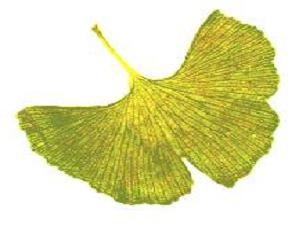Ginkgo: Difference between revisions
imported>David E. Volk m (typos) |
imported>Robert Badgett No edit summary |
||
| Line 26: | Line 26: | ||
Ginkgoes are [[dioecious]], though the two [[sex]]s are similar in morphology until about 30 years old<ref name=Hori1997 />. Among other identifying characteristics, female trees develop edible but foul-smelling [[seed]]s in the [[autumn]]<ref name=Soma1997>Soma, S. Development of the female gametophyte and the embryogeny of Ginkgo biloba. (1997). In Hori, T. et al (Eds.), ''Ginkgo biloba, a global treasure: from biology to medicine''. New York: Springer-Verlag. pp. 51-65.</ref>. In the [[spring]], older ginkgoes will develop sporangia.They are a resilient species, able to withstand [[city]] [[pollution]] and [[fungus]] and [[insect]] attacks<ref name=Hori1997 />. One ginkgo in [[Hiroshima]], [[Japan]] even managed survive the atomic blast that leveled much of the city in [[World War II]]<ref name=Gorman1997>Gorman, C. (1997). More than a funny name. ''Time''. November 3, p. 53.</ref>. | Ginkgoes are [[dioecious]], though the two [[sex]]s are similar in morphology until about 30 years old<ref name=Hori1997 />. Among other identifying characteristics, female trees develop edible but foul-smelling [[seed]]s in the [[autumn]]<ref name=Soma1997>Soma, S. Development of the female gametophyte and the embryogeny of Ginkgo biloba. (1997). In Hori, T. et al (Eds.), ''Ginkgo biloba, a global treasure: from biology to medicine''. New York: Springer-Verlag. pp. 51-65.</ref>. In the [[spring]], older ginkgoes will develop sporangia.They are a resilient species, able to withstand [[city]] [[pollution]] and [[fungus]] and [[insect]] attacks<ref name=Hori1997 />. One ginkgo in [[Hiroshima]], [[Japan]] even managed survive the atomic blast that leveled much of the city in [[World War II]]<ref name=Gorman1997>Gorman, C. (1997). More than a funny name. ''Time''. November 3, p. 53.</ref>. | ||
Ginkgoes have | ==Clinical role== | ||
Ginkgoes may have medical applications. The extract [[EGb 761]]has also been used to treat hearing problems, [[impotence]], [[circulatory system|circulatory]] problems, and [[oxygen]] deprivation<ref name=Gorman1997 />. | |||
[[Ginkgo biloba]] does not prevent dementia according to a large [[randomized controlled trial]]<ref name="pmid19017911">{{cite journal |author=DeKosky ST, Williamson JD, Fitzpatrick AL, ''et al'' |title=Ginkgo biloba for prevention of dementia: a randomized controlled trial |journal=JAMA |volume=300 |issue=19 |pages=2253–62 |year=2008 |month=November |pmid=19017911 |doi=10.1001/jama.2008.683 |url=http://jama.ama-assn.org/cgi/pmidlookup?view=long&pmid=19017911 |issn=}}</ref> and [[systematic review]]<ref name="pmid19160216">{{cite journal |author=Birks J, Grimley Evans J |title=Ginkgo biloba for cognitive impairment and dementia |journal=Cochrane Database Syst Rev |volume= |issue=1 |pages=CD003120 |year=2009 |pmid=19160216 |doi=10.1002/14651858.CD003120.pub3 |url=http://dx.doi.org/10.1002/14651858.CD003120.pub3 |issn=}}</ref> by the [[Cochrane Collaboration]]. | |||
==References== | ==References== | ||
<references/> | <references/> | ||
Revision as of 14:02, 7 March 2009
| Ginkgo biloba | ||||||||||||||
|---|---|---|---|---|---|---|---|---|---|---|---|---|---|---|
 A ginkgo leaf
| ||||||||||||||
| Scientific classification | ||||||||||||||
|
Ginkgo (or maidenhair) is the common name for the tree Ginkgo biloba.
The Ginkgo family first appeared 200 to 225 million years ago[1], in the Paleozoic era. Ginkgoes were widespread about 100 million years ago, but now they only exist in a wild state in a remote region in China. However, they have been widely exported to the rest of the world as an ornamental tree, where ginkgoes are also known as "maidenhair" trees[1]. The ginkgo is the only living member of its phylum.
Ginkgoes are unique in the plant kingdom, as evidenced by their sole membership of the Ginkgophyta phylum. For one thing, they are possibly the only plants to have centrioles. Ginkgoes represent the only extant link between lower and higher plants because of their method of fertilization, which involves swimming sperm[1].
Ginkgoes are dioecious, though the two sexs are similar in morphology until about 30 years old[1]. Among other identifying characteristics, female trees develop edible but foul-smelling seeds in the autumn[2]. In the spring, older ginkgoes will develop sporangia.They are a resilient species, able to withstand city pollution and fungus and insect attacks[1]. One ginkgo in Hiroshima, Japan even managed survive the atomic blast that leveled much of the city in World War II[3].
Clinical role
Ginkgoes may have medical applications. The extract EGb 761has also been used to treat hearing problems, impotence, circulatory problems, and oxygen deprivation[3].
Ginkgo biloba does not prevent dementia according to a large randomized controlled trial[4] and systematic review[5] by the Cochrane Collaboration.
References
- ↑ 1.0 1.1 1.2 1.3 1.4 Hori, T., Ridge, R.W., Tulecke, W., Del Tredici, P., Trémouillauw-Guiller, J., and H. Tobe. (1997). Preface. In Hori, T. et al (Eds.), Ginkgo biloba, a global treasure: from biology to medicine. New York: Springer-Verlag. pp. vii-ix.
- ↑ Soma, S. Development of the female gametophyte and the embryogeny of Ginkgo biloba. (1997). In Hori, T. et al (Eds.), Ginkgo biloba, a global treasure: from biology to medicine. New York: Springer-Verlag. pp. 51-65.
- ↑ 3.0 3.1 Gorman, C. (1997). More than a funny name. Time. November 3, p. 53.
- ↑ DeKosky ST, Williamson JD, Fitzpatrick AL, et al (November 2008). "Ginkgo biloba for prevention of dementia: a randomized controlled trial". JAMA 300 (19): 2253–62. DOI:10.1001/jama.2008.683. PMID 19017911. Research Blogging.
- ↑ Birks J, Grimley Evans J (2009). "Ginkgo biloba for cognitive impairment and dementia". Cochrane Database Syst Rev (1): CD003120. DOI:10.1002/14651858.CD003120.pub3. PMID 19160216. Research Blogging.